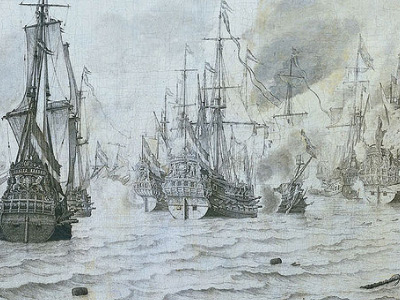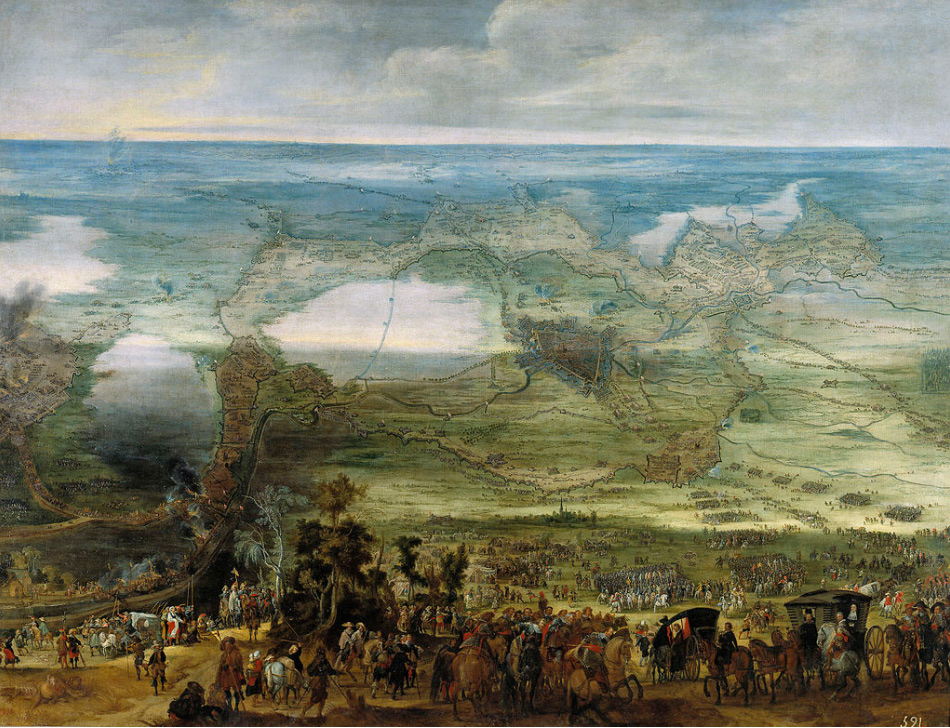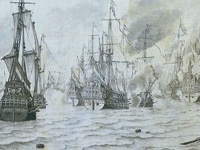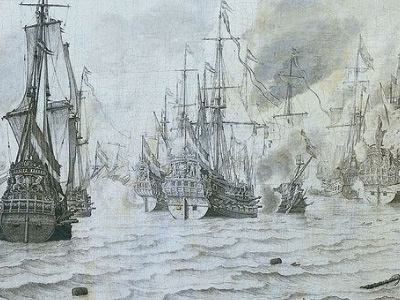Eighty Years' War (1568–1648)

The Republic Under Siege (1621–1629)
Another reason the war did not immediately resume was that king Philip III died shortly before the Truce ended. He was succeeded by his 16-year-old son Philip IV, and the new government under Gaspar de Guzmán, Count-Duke of Olivares had to get settled. The view in the Spanish The Spanish Empire was a colonial empire governed by Spain and its predecessor states between 1492 and 1976. One of the largest empires in history, it was the first to usher the European Age of Discovery and achieve a global scale, controlling vast territory. It was one of the most powerful empires of the early modern period, reaching its maximum extent in the 18th century. government was that the Truce had been ruinous to Spain in an economic sense. In this view the Truce had enabled the Dutch
The Spanish Empire was a colonial empire governed by Spain and its predecessor states between 1492 and 1976. One of the largest empires in history, it was the first to usher the European Age of Discovery and achieve a global scale, controlling vast territory. It was one of the most powerful empires of the early modern period, reaching its maximum extent in the 18th century. government was that the Truce had been ruinous to Spain in an economic sense. In this view the Truce had enabled the Dutch The Dutch Republic was a confederation that existed from 1579, during the Dutch Revolt, to 1795. It was a predecessor state of the Netherlands and the first fully independent Dutch nation state. Although the state was small and contained only around 1.5 million inhabitants, it controlled a worldwide network of seafaring trade routes. The income from this trade allowed the Dutch Republic to compete militarily against much larger countries. It amassed a huge fleet of 2,000 ships, initially larger than the fleets of England and France combined. to gain very unequal advantages in the trade with the Iberian Peninsula and the Mediterranean, owing to their mercantile prowess. On the other hand, the continued blockade of Antwerp had contributed to that city's steep decline in importance (hence the demand for the lifting of the closing of the Scheldt). The shift in the terms of trade between Spain and the Republic had resulted in a permanent trade deficit for Spain, which naturally translated into a drain of Spanish silver to the Republic. The Truce had also given further impetus to the Dutch penetration of the East Indies, and in 1615 a naval expedition under Joris van Spilbergen had raided the West-Coast of Spanish South-America. Spain felt threatened by these incursions and wanted to put a stop to them. Finally, the economic advantages had given the Republic the financial wherewithal to build a large navy during the Truce and to enlarge its standing army to a size where it could rival the Spanish military might. This increased military power appeared to be directed principally to thwart Spain's policy objectives, as witnessed by the Dutch interventions in Germany in 1614 and 1619, and the Dutch alliance with the enemies of Spain in the Mediterranean, like Venice and the Sultan of Morocco. The three conditions Spain had set for a continuation of the Truce had been intended to remedy these disadvantages of the Truce (the demand for freedom of worship for Catholics being made as a matter of principle, but also to mobilise the still sizeable Catholic minority in the Republic and so destabilise it politically).
The Dutch Republic was a confederation that existed from 1579, during the Dutch Revolt, to 1795. It was a predecessor state of the Netherlands and the first fully independent Dutch nation state. Although the state was small and contained only around 1.5 million inhabitants, it controlled a worldwide network of seafaring trade routes. The income from this trade allowed the Dutch Republic to compete militarily against much larger countries. It amassed a huge fleet of 2,000 ships, initially larger than the fleets of England and France combined. to gain very unequal advantages in the trade with the Iberian Peninsula and the Mediterranean, owing to their mercantile prowess. On the other hand, the continued blockade of Antwerp had contributed to that city's steep decline in importance (hence the demand for the lifting of the closing of the Scheldt). The shift in the terms of trade between Spain and the Republic had resulted in a permanent trade deficit for Spain, which naturally translated into a drain of Spanish silver to the Republic. The Truce had also given further impetus to the Dutch penetration of the East Indies, and in 1615 a naval expedition under Joris van Spilbergen had raided the West-Coast of Spanish South-America. Spain felt threatened by these incursions and wanted to put a stop to them. Finally, the economic advantages had given the Republic the financial wherewithal to build a large navy during the Truce and to enlarge its standing army to a size where it could rival the Spanish military might. This increased military power appeared to be directed principally to thwart Spain's policy objectives, as witnessed by the Dutch interventions in Germany in 1614 and 1619, and the Dutch alliance with the enemies of Spain in the Mediterranean, like Venice and the Sultan of Morocco. The three conditions Spain had set for a continuation of the Truce had been intended to remedy these disadvantages of the Truce (the demand for freedom of worship for Catholics being made as a matter of principle, but also to mobilise the still sizeable Catholic minority in the Republic and so destabilise it politically).
Despite the unfortunate impression the opening speech of chancellor Peckius had made at the negotiations about the renewal of the Truce, the objective of Spain and the regime in Brussels was not a war of reconquest of the Republic. Instead the options considered in Madrid were either a limited exercise of the force of weapons, to capture a few of the strategic points the republic had recently acquired (like Cleves), combined with measures of economic warfare, or reliance on economic warfare alone. Spain opted for the first alternative. Immediately after the expiration of the Truce in April 1621, all Dutch ships were ordered out of Spanish ports, and the stringent trade embargoes of before 1609 were renewed. After an interval to rebuild the strength of the Army of Flanders, Spinola opened a number of land offensives, in which he captured the fortress of Jülich (garrisoned by the Dutch since 1614) in 1622, and Steenbergen in Brabant, before laying siege to the important fortress city of Bergen-op-Zoom. This proved a costly fiasco as Spinola's besieging army of 18,000 melted away through disease and desertion. He therefore had to lift the siege after a few months. The strategic import of this humiliating experience was that the Spanish government now concluded that besieging the strong Dutch fortresses was a waste of time and money and decided to henceforth solely depend on the economic warfare weapon. The subsequent success of Spinola's siege of Breda did not change this decision, and Spain adopted a defensive stance militarily in the Netherlands.

Painting of the siege of Breda in 1624

Painting of the siege of Breda in 1624
( Click image to enlarge)
However, the economic warfare was intensified in a way that amounted to a veritable siege of the Republic as a whole. In the first place, the naval war intensified. The Spanish navy harassed Dutch shipping, which had to sail through the Strait of Gibraltar to Italy and the Levant, thereby forcing the Dutch to sail in convoys with naval escorts. The cost of this was borne by the merchants in the form of a special tax, used to finance the Dutch navy, but this increased the shipping rates the Dutch had to charge, and their maritime insurance premiums also were higher, thus making Dutch shipping less competitive. Spain also increased the presence of its navy in Dutch home waters, in the form of the armada of Flanders, and the great number of privateers, the Dunkirkers, both based in the Southern Netherlands. Though these Spanish naval forces were not strong enough to contest Dutch naval supremacy, Spain waged a very successful Guerre de Course, especially against the Dutch herring fisheries, despite attempts by the Dutch to blockade the Flemish coast.
The herring trade, an important pillar of the Dutch economy, was hurt much by the other Spanish forms of economic warfare, the embargo on salt for preserving herring, and the blockade of the inland waterways to the Dutch hinterland, which were an important transportation route for Dutch transit trade. The Dutch were used to procuring their salt from Portugal and the Caribbean islands. Alternative salt supplies were available from France The Kingdom of France is the historiographical name or umbrella term given to various political entities of France in the medieval and early modern period. It was one of the most powerful states in Europe since the High Middle Ages. It was also an early colonial power, with possessions around the world. Colonial conflicts with Great Britain led to the loss of much of its North American holdings by 1763. The Kingdom of France adopted a written constitution in 1791, but the Kingdom was abolished a year later and replaced with the First French Republic., but the French salt had a high magnesium content, which made it less suitable for herring preservation. When the supplies in the Spanish sphere of influence were cut off, the Dutch economy was therefore dealt a heavy blow. The salt embargo was just a part of the more general embargo on Dutch shipping and trade that Spain instituted after 1621. The bite of this embargo grew only gradually, because the Dutch at first tried to evade it by putting their trade in neutral bottoms, like the ships of the Hanseatic League and England
The Kingdom of France is the historiographical name or umbrella term given to various political entities of France in the medieval and early modern period. It was one of the most powerful states in Europe since the High Middle Ages. It was also an early colonial power, with possessions around the world. Colonial conflicts with Great Britain led to the loss of much of its North American holdings by 1763. The Kingdom of France adopted a written constitution in 1791, but the Kingdom was abolished a year later and replaced with the First French Republic., but the French salt had a high magnesium content, which made it less suitable for herring preservation. When the supplies in the Spanish sphere of influence were cut off, the Dutch economy was therefore dealt a heavy blow. The salt embargo was just a part of the more general embargo on Dutch shipping and trade that Spain instituted after 1621. The bite of this embargo grew only gradually, because the Dutch at first tried to evade it by putting their trade in neutral bottoms, like the ships of the Hanseatic League and England The Kingdom of England was a sovereign state on the island of Great Britain from about 927, when it emerged from various Anglo-Saxon kingdoms, until 1 May 1707, when it united with Scotland to form the Kingdom of Great Britain. The Viking invasions of the 9th century upset the balance of power between the English kingdoms, and native Anglo-Saxon life in general. The English lands were unified in the 10th century in a reconquest completed by King Æthelstan in 927.. Spanish merchants tried to evade it, as the embargo also did great harm to Spanish economic interests, even to the extent that for a time a famine threatened in Spanish Naples when the Dutch-carried grain trade was cut off. Realizing that the local authorities often sabotaged the embargo, the Spanish crown built up an elaborate enforcement apparatus, the Almirantazgo de los países septentrionales (Admiralty of the northern countries) in 1624 to make it more effective. Part of the new system was a network of inspectors in neutral ports who inspected neutral shipping for goods with a Dutch connection and supplied certificates that protected neutral shippers against confiscation in Spanish ports. The English and Hanseatics were only too happy to comply, and so contributed to the effectiveness of the embargo.
The Kingdom of England was a sovereign state on the island of Great Britain from about 927, when it emerged from various Anglo-Saxon kingdoms, until 1 May 1707, when it united with Scotland to form the Kingdom of Great Britain. The Viking invasions of the 9th century upset the balance of power between the English kingdoms, and native Anglo-Saxon life in general. The English lands were unified in the 10th century in a reconquest completed by King Æthelstan in 927.. Spanish merchants tried to evade it, as the embargo also did great harm to Spanish economic interests, even to the extent that for a time a famine threatened in Spanish Naples when the Dutch-carried grain trade was cut off. Realizing that the local authorities often sabotaged the embargo, the Spanish crown built up an elaborate enforcement apparatus, the Almirantazgo de los países septentrionales (Admiralty of the northern countries) in 1624 to make it more effective. Part of the new system was a network of inspectors in neutral ports who inspected neutral shipping for goods with a Dutch connection and supplied certificates that protected neutral shippers against confiscation in Spanish ports. The English and Hanseatics were only too happy to comply, and so contributed to the effectiveness of the embargo.
The embargo grew to an effective direct and indirect impediment for Dutch trade, as not only the direct trade between the Amsterdam Entrepôt and the lands of the Spanish empire was affected, but also the parts of Dutch trade that indirectly depended on it: Baltic grain and naval stores destined for Spain were now provided by others, depressing the Dutch trade with the Baltic area, and the carrying trade between Spain and Italy now shifted to English shipping. The embargo was a double-edged sword, however, as some Spanish and Portuguese export activities likewise collapsed as a consequence (such as the Valencian and Portuguese salt exports).
Spain was also able to physically close off inland waterways for Dutch river traffic after 1625. The Dutch were thus also deprived of their important transit trade with the neutral Prince-Bishopric of Liège (then not a part of the Southern Netherlands) and the German hinterland. Dutch butter and cheese prices collapsed as a result of this blockade (and rose steeply in the affected import areas), as did wine and herring prices (the Dutch monopolised the French wine trade at the time). The steep price rises in the Spanish Netherlands were sometimes accompanied by food shortages, however, leading to an eventual relaxation of this embargo. It was eventually abandoned, because it deprived the Brussels authorities from important revenues from custom duties.
The economic warfare measures of Spain were effective in the sense that they depressed economic activity in the Netherlands, thereby also depressing Dutch fiscal resources to finance the war effort, but also by structurally altering European trade relations, at least until the end of the war, after which they reverted in favour of the Dutch. Neutrals benefited, but both the Dutch and the Spanish areas suffered economically, though not uniformly, as some industrial areas benefited from the artificial restriction of trade, which had a protectionist effect. The "new draperies" textile industry in Holland permanently lost terrain to its competitors in Flanders and England, though this was compensated for by a shift to more expensive high-quality woollens. Nevertheless, the economic pressure and the slump of trade and industry it caused was not sufficient to bring the Republic to its knees. There were a number of reasons for this. The chartered companies, both VOC and WIC, provided employment on a large enough scale to compensate for the slump in other forms of trade and their trade brought great revenues. Supplying the armies, both in the Netherlands and in Germany, proved a boon for the agricultural areas in the Dutch inland provinces.
The fiscal situation of the Dutch government also improved after the death of Maurice in 1625. He had been too successful in gathering all reins of government in his own hands after his coup in 1618. He completely dominated Dutch politics and diplomacy in his first years afterwards, even monopolising the abortive peace talks before the expiration of the Truce. Likewise the political Counter-Remonstrants were temporarily in total control, but the downside was that his government was overextended, with too few people doing the heavy lifting at the local level, which was essential to make the government machine run smoothly in the highly decentralised Dutch polity. Holland's conventional role as leader of the political process was temporarily vacated, as Holland as a power center was eliminated. Maurice had to do everything by himself with his small band of aristocratic managers in the States General. This situation deteriorated even more when he had to spend long periods in the field as commander-in-chief, during which he was unable to personally direct affairs in The Hague. His health soon deteriorated, also detracting from his efficacy as a political and military leader. The regime, depending on Maurice's personal qualities as a virtual dictator, therefore came under unbearable strain.
Not surprisingly, in the period up to his death the strategic and military position of the Republic deteriorated. It had to increase the standing army to 48,000 men in 1622, just to hold the defensive ring of fortresses, while Spain increased the Army of Flanders to 60,000 men at the same time. This put a great strain on the Republic's finances at a time when tax rates were already dangerously high. Yet at the same time the Republic had no other option than to sustain the imploding German Protestant forces financially. For that reason the Dutch paid for the army of Count Ernst von Mansfeld that was cowering against the Dutch border in East Friesland after its defeats against the Spanish and Imperial forces; it was hoped that in this way a complete encirclement of the Republic could be avoided. For a while the Republic pinned its hope on Christian the Younger of Brunswick. However, his Dutch-financed army was crushed at Stadtlohn, near the Dutch border by the forces of the Catholic League under Tilly in August 1623. This setback necessitated a reinforcement of the Dutch IJssel line. Spinola, however, failed to take advantage of the new situation, lulled into complacency by Maurice's unceasing peace-feelers. He was back in 1624, however, besieging Breda, and Dutch morale slumped, despite the diplomatic success of the Treaty of Compiègne with Louis XIII of France, in which the latter agreed to support the Dutch military effort with an annual subsidy of a million guilders (7% of the Dutch war budget).
Maurice died in April 1625, aged 58, and was succeeded as Prince of Orange and captain-general of the Union by his half-brother Frederick Henry, Prince of Orange. It took several months, however, to obtain his appointment as stadtholder of Holland and Zeeland, as it took time to agree on the terms of his commission. This deprived the regime of leadership in a crucial time. During this time the moderate Calvinist regents staged a return in Holland at the expense of the radical Counter-Remonstrants. This was an important development, as Frederick Henry could not lean exclusively on the latter faction, but instead took a position "above the parties", playing the two factions against one another. A side effect of this was that more normal political relations returned to the Republic, with Holland returning to its central political position. Also, the persecution of the Remonstrants now abated with the Prince's connivance, and with this renewed climate of tolerance, political stability in the Republic also improved.
This improvement in internal affairs helped the Republic overcome the difficult years of the sharpest economic warfare phase. During the lull in the military pressure by Spain after the fall of Breda in 1625, the Republic was able to steadily increase its standing army, owing to its improved financial situation. This enabled the new stadtholder of Friesland and Groningen, Ernst Casimir, to recapture Oldenzaal, forcing the Spanish troops to evacuate Overijssel. Diplomatically, the situation improved once England entered the war in 1625 as an ally. Frederick Henry cleared the Spaniards from eastern Gelderland in 1627 after recapturing Grol. The Dutch victory in the Battle in the Bay of Matanzas in 1628, in which a Spanish treasure fleet was captured by Piet Pieterszoon Hein, contributed even more to the improving fiscal situation, at the same time depriving Spain of much needed money. However, the greatest contribution to the improvement of the Dutch position in 1628 was that Spain had overextended itself again when it participated in the War of the Mantuan Succession. This caused such a depletion of Spanish troops and financial resources in the theatre of war in the Netherlands that the Republic for the time being achieved a strategic superiority: the Army of Flanders declined to 55,000 men while the States Army reached 58,000 in 1627.
HISTORY

RESOURCES
This article uses material from the Wikipedia article "Eighty Years' War (1568–1648)", which is released under the Creative Commons Attribution-Share-Alike License 3.0.
© Stories Preschool. All Rights Reserved.









